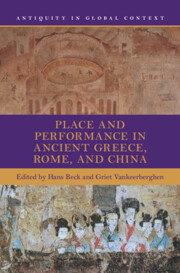Book contents
- Place and Performance in Ancient Greece, Rome, and China
- Antiquity in Global Context
- Place and Performance in Ancient Greece, Rome, and China
- Copyright page
- Contents
- Figures
- Tables
- Contributors
- Series Editors’ Preface
- Editors’ Preface
- Introduction
- Part I Crafting Space and Place
- Part II Performances of Power
- Chapter 3 Power and Its Trappings in the Han and Roman Bureaucracies
- Chapter 4 The ‘Performance’ of Agricultural Labour in Ancient Rome and Han China
- Chapter 5 Foreigners, Spectacles, and Imperial Performance
- Chapter 6 The Maiden and the Mirror
- Part III Urban Places
- Part IV Fringe Places and Endpoints
- Index
- References
Chapter 3 - Power and Its Trappings in the Han and Roman Bureaucracies
from Part II - Performances of Power
Published online by Cambridge University Press: 28 November 2024
- Place and Performance in Ancient Greece, Rome, and China
- Antiquity in Global Context
- Place and Performance in Ancient Greece, Rome, and China
- Copyright page
- Contents
- Figures
- Tables
- Contributors
- Series Editors’ Preface
- Editors’ Preface
- Introduction
- Part I Crafting Space and Place
- Part II Performances of Power
- Chapter 3 Power and Its Trappings in the Han and Roman Bureaucracies
- Chapter 4 The ‘Performance’ of Agricultural Labour in Ancient Rome and Han China
- Chapter 5 Foreigners, Spectacles, and Imperial Performance
- Chapter 6 The Maiden and the Mirror
- Part III Urban Places
- Part IV Fringe Places and Endpoints
- Index
- References
Summary
The chapters assembled in this part turn to the key question of how the exercise of power was subject to a broad array of performative practices, in places as diverse as the administration of the state, public spectacles, agricultural production, and literature. Taco Terpstra kicks off with the performative dimension of statecraft. Due to their substantiated degree of structured hierarchies, standardized procedures, and the ability to employ officials with specific assignments, the imperial administrations of Rome and Han China capture, in exemplary fashion, the design of premodern statehood. Yet both governments looked rather different. While the Chinese relied on a large apparatus of officials who were appointed and paid by the state, Rome governed via a notoriously narrow pool of magistrates whose bureaucratic powers quintessentially built on the support of countless unsalaried local elites. Terpstra’s discussion of these differences departs from an analysis of how administrative rank and agency were expressed through clothing and other symbols of power. Prima facie minor aspects of the grand scheme of empire, the study of Sima Biao’s (third century CE) Treatise on Carriages and Robes, and On the Magistracies of the Roman State by John the Lydian (sixth century CE) offer exciting insight into the ways in which state power was conceived of and articulated throughout the empire. The chapter then segues into the question of state formation and the emergence of bureaucratic structures. Terpstra discloses how, in China, the thrust toward performance-based appointments and promotions preconditioned the rise of a professional bureaucratic corps, whereas the Romans, he argues, actively discouraged such a development. Both dispositions had eminent consequences for the longue durée of state power.
- Type
- Chapter
- Information
- Place and Performance in Ancient Greece, Rome, and China , pp. 89 - 113Publisher: Cambridge University PressPrint publication year: 2024

